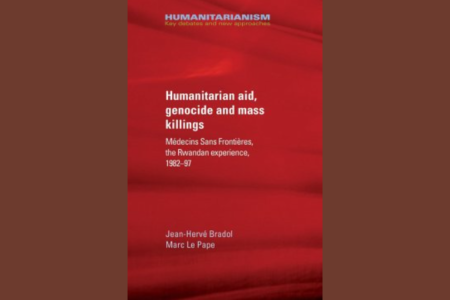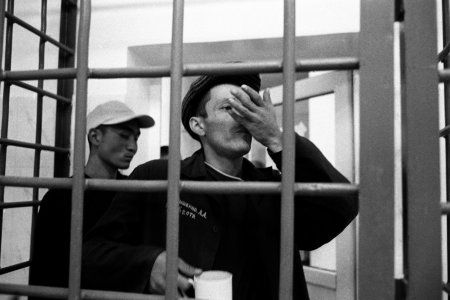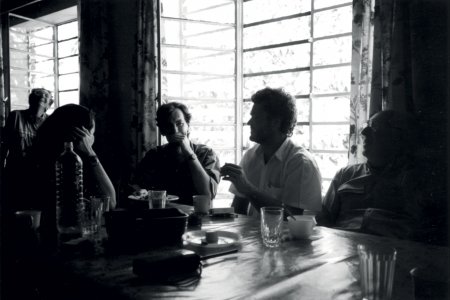
Patrick de Saint-Exupéry: a counterfaiter in Congo
Mego Terzian
In his book, "La Traversée. Une odyssée au cœur de l’Afrique", Patrick de Saint-Exupéry challenges the reality of Hutu Rwandan refugees’ hunt and massacre facing the advancement of the Rwandan Patriotic Army and their Congolese allies in 1996-97. This systematic exercise of denying reality – especially the denial of the Mapping Report written by the Office of the United Nations High Commissioner for Human Rights (1143 pages, published in June 2009) – but also this denial of Human Rights Advocacy groups’ investigations, and those of journalists’ witnesses present in DRC at the time – does not spare MSF’s teams who came to help these refugees in 1996-97. However, as a front-line witness of the Tutsi genocide in Rwanda, MSF was also one of the organizations noticing the intense violence perpetrated by the new Rwandan political regime in Zaire / DRC back in 1996 and 1997, mostly against a population constituted at three-quarters of women and children.
Although the book has already been critically reviewed by MSF members, the fake presentations of our archives’ contents deliberately presented by the author to accuse some members of our association of dramatizing and lying need to be addressed here in a detailed and specific answer.
Patrick de Saint-Exupéry relies in particular on two case studies made by MSF – free of access on MSF website – which documents the difficult operational and public communication choices of the organization that were taken in two crisis situations:
Most of the quotes from these documents are presented in a completely decontextualized manner as to confirm the author’s point of view: manipulated by diplomatic apparatus – especially the French ones – MSF and in particular its French section has adopted a “forceful denunciation strategy” of the new Rwandan authorities to “reaffirm its leadership on the movement”; the French section had, in that way, cynically invented crimes that did not exist.
The case studies of the “MSF Speaking Out” collection are public and give access to a huge quantity of archives, restituting the vivid debates that undoubtedly animated MSF when major crisis arose. In this case, Laurence Binet, author of the two volumes cited, gives to the reader documents relating the framework in which the discussions took place and the choices that were taken.
Patrick de Saint-Exupéry randomly takes out abstracts and puts them in the middle of remarks and quotes, giving them a meaning, they originally did not have, and sometimes omitted information contradicting his bias. The use he makes of these archives abstracts is thus exactly the opposite of the working principle that guided their elaboration.
On page 183, the journalist evokes the accusations made by Jean-Christophe Rufin against Jean-Hervé Bradol, without mentioning the latter’s response – which nevertheless directly follows the accusations in the document published in the case study. Further, on p.233, he extracts the formula “politique de liquidation totale” (policy of total liquidation) of an MSF-France press release dating back to April 26th, 1997, suggesting that MSF supports the double genocide stance. This stance is supported by a limited group of political figures and scholars; for MSF or anyone speaking in the name of MSF it was never about actually claiming a double genocide.
The author writes somewhere else (page 251): “En 1997, cette voie fut appelée “le couloir de la mort”: “Ubundu Kisangani, les mouroirs du rail”” (In 1997, this path was called “the death row”: “Ubundu Kisangani, the death rows of the rails””). Even though, the “death row” term matched the reality of mortality rates observed by MSF teams working back then in the region, and indeed comes from one of the headers of the case study, the term “couloir de la mort” (death row) was never used. Furthermore, according to the author, the testimonies are an exaggeration of MSF-France aiming to “reconquer its historical leadership of the organization by taking a radical position” (page 252). The reality is that colleagues in MSF's Belgian and Dutch sections also supported these descriptions, as show many passages in the study. There were a lot of debates and disagreements between sections about the speaking out methods but there was no dispute whatsoever on the reality of those acts of violence and mass crimes.
Further in the text (page 249), the author quotes the case of Marleen Monteyne, a doctor coming back from a mission, to affirm not finding any intervention proof of her saying “Rwandan soldiers are killing refugees”. Reading this part in “La Traversée”, one would have no idea that in an article published in the internal journal of MSF, “Messages” – also presented in the case study – Marleen Monteyne writes on the contrary: “We must dare to testify and denounce, to assume the consequences and not be content to passively stand by and watch the massacres / count the corpses”.
We will stop the enumeration of false statements with the misleading use of a quote (on page 251) from Samantha Bolton, Head of Communication for the US section of MSF, who – according to the author – was worried about a baseless communication. However, without ever questioning the reality of the massacres, it was as a communicator and after controversies over the figures of victims among Hutu refugees in the Zaïre camps who were deprived of assistance at the end of the year 1996 / beginning 1997 – that our colleague, was alerting us on the necessary precision in defining the denunciations’ contents.
More generally speaking, the reader of the book “La Traversée” will not know about the elements in Laurence Binet’s studies showing that massacres did take place – as show the reports of MSF teams in Chimanga, Shabunda and in the Masisi. In Shabunda, soldiers of the Rwandan Patriotic Army executed refugees encouraged to leave the dense forest by the presence of international organizations. Thousands of civilians were lured into this mortal trap from which they did not return. This episode is one of the most terrible in the contemporary humanitarian aid History but has oddly not sparked the author’s interest. Patrick de Saint-Exupéry did not go through the trouble of discussing with the people he incriminates, nor did he bother to check the sources: he straight up went digging into documents produced precisely to illustrate the complexity of decision-taking processes in situations of extreme violence.
In his book, Patrick de Saint-Exupéry throws away, discredits, or ignores all the elements indicating the responsibility of the Rwandan Patriotic Army and its Congolese allies in the massacres of Rwandan refugees in Zaire/DRC, only to highlight a small number of testimonies selected in an unexplained random fashion. Concerning MSF, this distortion of reality is made at the stake of the accumulation of misappropriations of both facts and documents’ contents that anyone reading the quoted above documents could easily check. Even though MSF does not provide legal proofs per se, the accumulation of similar narratives, testimonies, and reports all give a solid basis to discuss the violence Hutu Rwandan refugees have been victims of.
In his quest to demonstrate that a second genocide did not happen, Patrick de Saint-Exupéry denies what has been very thoroughly documented by MSF teams themselves: large-scale massacres of civilians, women, and children, committed in Zaire/DRC by militias equipped and supported by the Rwandan Patriotic Army. Remembering the 1994 Tutsi genocide victims is a human and political demand, just like it is legitimate and necessary to investigate on France’s – and other political actors’ – responsibilities in this tragedy. However, by trying to fight the French policy makers in the Great Lakes region of Africa and during the genocide in Rwanda, Patrick de Saint-Exupéry erases the traces of dozens of thousands of human killings. One can only be worried about how positively the book “La Traversée” was received.
Dr. Mego Terzian, MSF-France President,
October 27th, 2021
M. Patrick de Saint-Exupéry a souhaité exercer son droit de réponse, que nous avons publié le 10 novembre 2021 :
« Les nombreuses inexactitudes de l’article du Dr. Mego Terzian qui me qualifie aimablement de « faussaire au Congo », ce qui ne témoigne pas d’un très grand respect pour ma personne, et m’accuse sans nuance de « présentations frauduleuses », me contraignent à apporter les précisions suivantes au sujet de mon ouvrage « La traversée, une odyssée au cœur de l’Afrique », publié aux éditions Les Arènes, en mars 2021. En effet, le président de MSF-France me prête des propos que je ne tiens pas et des omissions qu’une lecture attentive suffit à démentir.
1. Page 183, la note en bas de page renvoie à un article du journal « Le Monde » du 21 décembre 1996 qui ne cite pas la réponse de Jean-Hervé Bradol aux accusations de Jean-Christophe Rufin.
2. Les termes « liquidation totale » et « politique d’extermination » figurent dans le communiqué de presse de MSF-France du 26 avril 1997 intitulé « Trois propositions pour mettre un terme à la politique d’extermination des réfugiés rwandais au Zaïre », cité page 223.
3. Page 234, et non pas 251, je dis en réalité : « En 1997, cette voie fut appelée le « couloir de la mort » : « Ubundu-Kisangani, les mouroirs du rail », écrivit MSF ». Seule l’omission de ces deux derniers mots provoque la confusion dénoncée qui n’existe pas.
4. L’intégralité de l’extrait du témoignage de Marleen Monteyne dont l’absence prétendue est reprochée figure page 250.
5. Les propos de Samantha Bolton cités page 251 ne portent pas à interprétation. Cette responsable de MSF souligne que « les seules preuves que MSF peut fournir en restant crédible sont des preuves médicales, en particulier depuis le déficit de crédibilité que nous avons enregistré sur la crise post-Kivu de septembre à décembre 1996 ».
6. Enfin, contrairement à ce qui est affirmé, la discussion porte sur la nature des violences dont les réfugiés ont fait l’objet, sur leur ampleur, sur les mots utilisés pour en rendre compte ; pas sur les violences elles-mêmes présentes tout au long de mon livre au travers de multiples témoignages. »
To cite this content :
Mego Terzian, “Patrick de Saint-Exupéry: a counterfaiter in Congo”, 27 octobre 2021, URL : https://msf-crash.org/en/war-and-humanitarianism/patrick-de-saint-exupery-counterfaiter-congo
If you would like to comment on this article, you can find us on social media or contact us here:
Contribute


